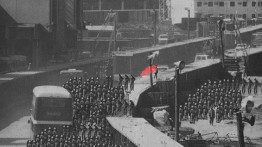Visiting Lecture | Ala Younis: Battles in a Future Estate
Tuesday, September 7, 2021, 12 - 2pm

Image Credit: Ala Younis, Baghdad Diaries – Haifa Street nightmare, 2018. Detail.
In 2006, US military intelligence cameras recorded the movements of American soldiers during the Battle of Haifa Street in Baghdad in Iraq. While soldiers were breaking into the apartments of high-rise buildings or hiding behind arches, the city’s contemporary landmarks appeared in the background of the images of the streets where Iraqi fighters were stationed. The houses that were broken into had never been exhibited in this way before, even though their plans had been shown in international magazines when they were designed by international architecture firms in the eighties. The architecture in Haifa Street was a conceptual prototype, a demonstration of the possibilities of a unique aesthetic discourse whose influence would seep, with its architects, from Baghdad to the rest of the region. The housing blocks were named after the nationality of the companies contracted to build them, and the blocks were entirely dedicated to a single type of resident. The 540 Dutch apartments were allocated to academics, the 400 German apartments were allocated to Syrian political dissidents who had taken refuge in Iraq, and the buildings in the first part of the project were allocated to government employees.
The art portraying Saddam Hussein in the Saddam Arts Centre, which stands in the middle of Haifa Street, covered almost the entire ground floor. The art in his palaces and scattered across the country were replicas of his face, and it is perhaps because of the appearance of similar art in the street that the US military became convinced of its residents’ loyalty to the regime in 2003. The American cameras not only filmed their soldiers’ attacks but also depicted the residents in a single light – as terrorists.
Today, pictures of these houses can be found on many real estate websites, allowing us to imagine how much it would cost to own one in a slowly recovering Baghdad.
This presentation will attempt to single out mono-cultural practices and strategies as they inform military, artistic and architectural images. It will also attempt to historicize the fragmentation that inform these testimonies.
The presentation will be followed by a discussion moderated by Nora Akawi and Sarah Saad.
Ala Younis is an artist who trained as an architect in Amman. Her practice involves research as well as curating, collaboration, film, and book projects. Her projects deal with collective experiences that collapse into personal ones, and how archives play on predilections and their lacunas and mishaps manipulate the imagination. Her work has been featured in shows in Amman, London, Seville, Sharjah, Dubai and New York. She has also taken part in Home Works: A Forum on Cultural Practices, Beirut; the Istanbul and Gwangju Biennials; and the New Museum Triennial, New York. Her work Plan for Greater Baghdad (2015) premiered at the 56th Venice Biennale. In 2018, she reproduced the timeline for the same project but from a female perspective, with the title Plan (fem) for Greater Baghdad. In 2013, she curated Kuwait’s first national pavilion at the 55th Venice Biennale and co-founded the publishing initiative Kayfa ta. She is co-head of Berlinale’s Forum Expanded and member of the Academy of Arts of the World, Cologne.
This event is free and accessible to the public.
View the full Fall 2021 Lectures and Events List.




